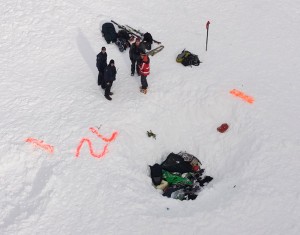
By David F. Rooney
A debriefing held by emergency services on Tuesday evening concluded that communications were — for a while, at least — the weak link in the community’s response to the Boulder Mountain avalanche that killed two people and injured 31.
“The initial lack of communications was very worrisome,” said Staff Sgt. Jacquie Olsen, who was the initial incident commander during the weekend avalanche. “For a while, we didn’t know what we were dealing with. We had reports to 10 dead, 50 dead, 100, 200 — then 10 again. It was very frustrating.”
That lack of accurate information was compounded by an unspecified problem with the Provincial Emergency Program antenna.
“We had issues with the antenna,” Olsen said in an interview Wednesday. “I understand that SAR has now ordered a new one. But our biggest challenge was dealing with the Incident Command System (ICS).”
ICS protocols call for Site Commanders at a disaster to organize emergency services personnel on the scene. They answer to one overall commander, called the Incident Commander, who has the final say on anything they decide.
When the avalanche occurred on Saturday the Revelstoke Mountain Resort dispatcher received a call at 3:27 pm from an RMR employee on Boulder Mountain saying there had been an avalanche. A minute later someone called the RCMP and also reported a large avalanche.
Within minutes helicopters from RMR, CMH and Selkirk Tangiers bearing experienced mountain guides, snow patrollers, SAR volunteers and other outdoors experts headed to Turbo Hill, which was the site of the avalanche.
Olsen said that, overall, they did a great job, but no one seemed to know who was — or should be — in charge.
“I won’t say there was a turf war going on, because it wasn’t exactly like that,” she said.
Olsen said they were working at cross-purposes until “Steve Parsons (RMR’s director of mountain operations) stepped up and made sure everything was being done right.”
“The best way to describe it is as organized chaos, but it worked out,” she said.
The other major communications weakness was the lack of someone who could direct all of the air traffic. There were eventually 14 helicopter flights to and from Boulder Mountain and there was no air traffic controller, either at the Incident Command Post at the RCMP Detachment building, or on-site at Boulder Mountain, Olsen said.
Fortunately, everything eventually did work and the RCMP detachment commander had nothing but praise for the people involved in the searches and rescues.
“You have to give them kudos,” she said. “They did a magnificent job.”
Elsewhere in town, things worked as predicted. Queen Victoria Hospital was “absolutely prepared.” Its staff called in the community’s doctors and nurses and prepared to receive “large numbers of casualties.” The BC Ambulance Service was on the ball, too. And, in a very grim move, the Executive Flight Centre hangar on Westside Road was designated as a temporary morgue to hold the large number of bodies that Olsen and the rest of the rescue organizers feared they might have to retrieve.
That this morgue was not needed was, fortunately, due in no small part to the fact that most of the people who were at Turbo Hill were prepared and properly equipped, Olsen said.
“The self-rescuing and the number of people — most of them, in fact — who were properly equipped and prepared made a real difference,” she said. “They came through and, as a consequence, lives were saved.”
That is reminiscent of the Canadian Avalanche’s assessment of the avalanche.
“The only reason this accident has not gone down in the history books as Canada’s worst avalanche accident is luck, coupled with the quick initial response,” the CAC said in a report, entitled The Boulder Mountain Avalanche Accident, March 13, Preliminary Report. “Without either, the outcome of this incident would have been much worse.”
Mayor David Raven, too, had praise for the way people reacted to the avalanche.
“You say we dodged a bullet,” he said in an interview. “It blew right past our ears.”
He said the rapid community response, especially by RMR, SAR, CMH and Selkirk Tangiers staff and helicopters helped avert a higher death toll. Survivors at the scene worked immediately to dig out people who were buried and tended to the injured, but without machines to transport the injured to town the death toll could have been worse. The swift arrival of the helicopters altered the equation of life and death.
“Without the helicopters and without their own machines — you have to remember most were destroyed — how many people would have died of shock or bled out?” Raven asked.
The two-day rescue effort was extremely expensive. Raven estimated it cost more than $1 million that will now be borne by the taxpayers of the province.
“I think we’ll see some changes,” he said.



